
United States Special Operations Command
USinfo | 2013-11-29 15:33
|
United States Special Operations Command — USSOCOM — |
|
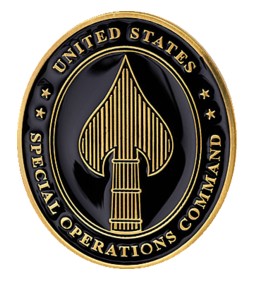 United States Special Operations Command emblem |
|
| Active | 16 April 1987 |
| Country | United States |
| Branch |
Unified Combatant Command Joint activity |
| Type | Special Operations |
| Role | Provide fully capable Special Operations Forces to defend the United States and its interests and plan and synchronize operations against terrorist networks |
| Size | 58,000 |
| Part of | Department of Defense |
| Garrison/HQ | MacDill Air Force Base |
| Nickname | USSOCOM or SOCOM |
| Engagements |
Operation Earnest Will Operation Just Cause Operation Desert Storm Operation Restore Hope Operation Gothic Serpent Battle of Mogadishu Operation Enduring Freedom Operation Iraqi Freedom Operation Neptune's Spear |
| Commanders | |
|
Current commander |
AdmiralWilliam H. McRaven |
The United States Special Operations Command (USSOCOM) is the Unified Combatant Command charged with overseeing the various Special Operations Commands (SOC or SOCOM) of the Army, Air Force, Navy and Marine Corps of the United States Armed Forces. The command is part of the Department of Defense. USSOCOM is headquartered at MacDill Air Force Base in Tampa, Florida.
The idea of a unified special operations command had its origins in the aftermath of Operation Eagle Claw, the disastrous attempted rescue of hostages at the American embassy in Iran in 1980. The ensuing investigation, chaired by AdmiralJames L. Holloway III, the retired Chief of Naval Operations, cited lack of command and control and inter-service coordination as significant factors in the failure of the mission.Since its activation on 16 April 1987, U.S. Special Operations Command has participated in many operations, from the 1989 invasion of Panama to the ongoing War On Terror.
USSOCOM conducts several covert and clandestine missions, such as unconventional warfare, foreign internal defense, special reconnaissance, psychological warfare, civil affairs, direct action, counter-terrorism and War on Drugs operations. Each branch has a Special Operations Command that is unique and capable of running its own operations, but when the different Special Operations Forces need to work together for an operation, USSOCOM becomes the joint component command of the operation, instead of a SOC of a specific branch.
History
The unworkable command and control structure of separate US military special operations forces (SOF), which led to the failure of Operation Eagle Claw in 1980, highlighted the need within the Department of Defense for reform and reorganization. The Army Chief of Staff, General Edward C. “Shy” Meyer, called for a further restructuring of special operations capabilities, eventually helping to create the US Delta Force.[5] Although unsuccessful at the joint level, Meyer nevertheless went on to consolidate Army SOF units under the new 1st Special Operations Command in 1982, a significant step to improve the US Army's SOF.
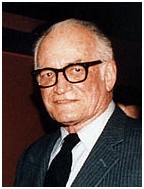
Senator Barry Goldwater Former Chairman of the Senate Armed Services Committee
By 1983, there was a small but growing sense in the Congress for the need for military reforms. In June, the Senate Armed Services Committee (SASC), under the chairmanship of Senator Barry Goldwater (R-AZ), began a two-year long study of the Defense Department which included an examination of SOF. With concern mounting on Capitol Hill, the Department of Defense created the Joint Special Operations Agency on 1 January 1984; this agency, however, had neither operational nor command authority over any SOF.The Joint Special Operations Agency thus did little to improve SOF readiness, capabilities, or policies, and therefore was insufficient. Within the Defense Department, there were a few staunch SOF supporters. Noel Koch, Principal Deputy Assistant Secretary of Defense for International Security Affairs, and his deputy, Lynn Rylander, both advocated SOF reforms.
At the same time, a few on Capitol Hill were determined to overhaul SOF. They included Senators Sam Nunn (D-GA) and William Cohen (R-ME), both members of the Armed Services Committee, and Representative Dan Daniel (D-VA), the chairman of the United States House Armed Services Subcommittee on Readiness. Congressman Daniel had become convinced that the U.S. military establishment was not interested in special operations, that the country’s capability in this area was second rate, and that SOF operational command and control was an endemic problem.Senators Nunn and Cohen also felt strongly that the Department of Defense was not preparing adequately for future threats. Senator Cohen agreed that the U.S. needed a clearer organizational focus and chain of command for special operations to deal with low-intensity conflicts.
In October 1985, the Senate Armed Services Committee published the results of its two-year review of the U.S. military structure, entitled "Defense Organization: The Need For Change."Mr. James R. Locher III, the principal author of this study, also examined past special operations and speculated on the most likely future threats. This influential document led to the Goldwater-Nichols Defense Reorganization Act of 1986.By spring 1986, SOF advocates had introduced reform bills in both houses of Congress. On 15 May, Senator Cohen introduced the Senate bill, co-sponsored by Senator Nunn and others, which called for a joint military organization for SOF and the establishment of an office in the Defense Department to ensure adequate funding and policy emphasis for low-intensity conflict and special operations. Representative Daniel’s proposal went even further—he wanted a national special operations agency headed by a civilian who would bypass the Joint Chiefs and report directly to the Secretary of Defense; this would keep Joint Chiefs and the Services out of the SOF budget process.
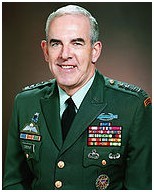
General James Lindsay the first Commander in Chief, Special Operations Command
Congress held hearings on the two bills in the summer of 1986. Admiral William J. Crowe Jr., Chairman of the Joint Chiefs of Staff, led the Pentagon’s opposition to the bills. He proposed, as an alternative, a new Special Operations Forces command led by a three-star general. This proposal was not well received on Capitol Hill—Congress wanted a four-star general in charge to give SOF more clout. A number of retired military officers and others testified in favor of the need for reform.By most accounts, retired Army Major General Richard Scholtes gave the most compelling reasons for change. Scholtes, who commanded the joint special operations task force in Grenada, explained how conventional force leaders misused SOF during the operation, not allowing them to use their unique capabilities, which resulted in high SOF casualties. After his formal testimony, Scholtes met privately with a small number of Senators to elaborate on the problems that he had encountered in Grenada.
Both the House and Senate passed SOF reform bills, and these went to a conference committee for reconciliation. Senate and House conferees forged a compromise. The bill called for a unified combatant command headed by a four star general for all SOF, an Assistant Secretary of Defense for Special Operations and Low-Intensity Conflict, a coordinating board for low-intensity conflict within the National Security Council, and a new Major Force Program (MFP-11) for SOF (the so-called "SOF checkbook"). The final bill, attached as a rider to the 1987 Defense Authorization Act, amended the Goldwater-Nichols Act and was signed into law in October 1986. Congress clearly intended to force DOD and the Administration to face up to the realities of past failures and emerging threats. DOD and the Administration were responsible for implementing the law, and Congress subsequently had to pass two additional bills to ensure proper implementation.The legislation promised to improve SOF in several respects. Once implemented, MFP-11 provided SOF with control over its own resources, better enabling it to modernize the force. Additionally, the law fostered interservice cooperation: a single commander for all SOF promoted interoperability among the forces assigned to the same command. The establishment of a four-star Commander in Chief and an Assistant Secretary of Defense for Special Operations and Low Intensity Conflict eventually gave SOF a voice in the highest councils of the Defense Department.
Implementing the provisions and mandates of the Nunn-Cohen Act, however, was neither rapid nor smooth. One of the first issues to surface was appointing an ASD (SO/LIC), whose principal duties included monitorship of special operations activities and low-intensity conflict activities of the Department of Defense. The Congress even increased the number of assistant secretaries of defense from 11 to 12, but the Department of Defense still did not fill this new billet. In December 1987, the Congress directed Secretary of the ArmyJohn O. Marsh to carry out the ASD (SO/LIC) duties until a suitable replacement was approved by the Senate. Not until 18 months after the legislation passed did Ambassador Charles Whitehouse assume the duties of ASD (SO/LIC).
Meanwhile, the establishment of USSOCOM provided its own measure of excitement. A quick solution to manning and basing a brand new unified command was to abolish an existing command. United States Readiness Command (USREDCOM), with an often misunderstood mission, did not appear to have a viable mission in the post Goldwater-Nichols era, and its Commander in Chief, General James Lindsay, had had some special operations experience. On 23 January 1987, the Joint Chiefs of Staff recommended to the Secretary of Defense that USREDCOM be disestablished to provide billets and facilities for USSOCOM. President Ronald Reagan approved the establishment of the new command on 13 April 1987. The Department of Defense activated USSOCOM on 16 April 1987 and nominated General Lindsay to be the first Commander in Chief Special Operations Command (USCINCSOC). The Senate accepted him without debate.
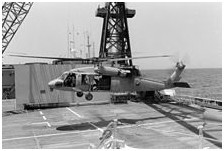
MH-60 landing on Hercules
Operation Earnest Will
USSOCOM's first tactical operation involved SEALs, Special Boat Teams (SBT), and 160th Special Operations Aviation Regiment (Airborne) ("Night Stalkers") aviators working together during Operation Earnest Will in September 1987. During Operation Earnest Will, the United States ensured that neutral oil tankers and other merchant ships could safely transit the Persian Gulf during the Iran–Iraq War. Iranian attacks on tankers prompted Kuwait to ask the United States in December 1986 to register 11 Kuwaiti tankers as American ships so that they could be escorted by the U.S. Navy. President Reagan agreed to the Kuwaiti request on 10 March 1987, hoping it would deter Iranian attacks.The protection offered by U.S. naval vessels, however, did not stop Iran, which used mines and small boats to harass the convoys steaming to and from Kuwait. In late July 1987, Rear Admiral Harold J. Bernsen, commander of the Middle East Force, requested NSW assets. Special Boat Teams deployed with six Mark III Patrol Boats and two SEAL platoons in August.The Middle East Force decided to convert two oil servicing barges, Hercules and Wimbrown VII, into mobile sea bases. The mobile sea bases allowed SOF in the northern Persian Gulf to thwart clandestine Iranian mining and small boat attacks.
On 21 September, Nightstalkers flying MH-6 and AH-6 Little Birds took off from the frigate Jarrett to track an Iranian ship, the Iran Ajr. The Nightstalkers observed the Iran Ajr turn off its lights and begin laying mines. After receiving permission to attack, the helicopters fired guns and rockets, stopping the ship. As the Iran Ajr’s crew began to push mines over the side, the helicopters resumed firing until the crew abandoned ship. Special Boat Teams provided security while a SEAL team boarded the vessel at first light and discovered nine mines on the vessel’s deck, as well as a logbook revealing areas where previous mines had been laid. The logbook implicated Iran in mining international waters.
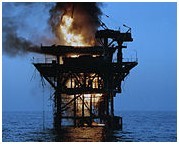

One of two Iranian oil platform set ablaze after shelling by American destroyers.
Within a few days, the Special Operations forces had determined the Iranian pattern of activity; the Iranians hid during the day near oil and gas platforms in Iranian waters and at night they headed toward the Middle Shoals Buoy, a navigation aid for tankers. With this knowledge, SOF launched three Little Bird helicopters and two patrol craft to the buoy. The Little Bird helicopters arrived first and were fired upon by three Iranian boats anchored near the buoy. After a short but intense firefight, the helicopters sank all three boats. In mid-October, three days after an Iranian Silkworm missile hit the tanker Sea Isle City near the oil terminal outside Kuwait City. Seventeen crewmen and the American captain were injured in the missile attack.During Operation Nimble Archer, four destroyers shelled two oil platforms in the Rostam oil field. After the shelling, a SEAL platoon and a demolition unit planted explosives on one of the platforms to destroy it. The SEALs next boarded and searched a third platform two miles away. Documents and radios were taken for intelligence purposes.
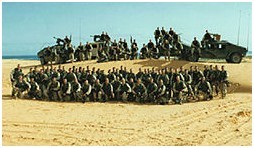
Bravo Company, 3rd Battalion of the 75th Ranger Regiment in Somalia, 1993.
On 14 April 1988, 65 miles east of Bahrain, the frigate USS Samuel B. Roberts (FFG-58) hit a mine, blowing an immense hole in its hull.Ten sailors were injured. During Operation Praying Mantis the U.S. retaliated fiercely, attacking the Iranian frigate Sabalan and oil platforms in the Sirri and Sassan oil fields.After U.S. warships bombarded the Sirri platform and set it ablaze, a UH-60 with a SEAL platoon flew toward the platform but was unable to get close enough because of the roaring fire. Secondary explosions soon wrecked the platform.Thereafter, Iranian attacks on neutral ships dropped drastically. On 18 July, Iran accepted the United Nations cease fire; on 20 August 1988, the Iran–Iraq War ended. The remaining SEALs, patrol boats, and helicopters then returned to the United States.Special Operations Forces provided critical skills necessary to help CENTCOM gain control of the northern Persian Gulf and balk Iran’s small boats and minelayers. The ability to work at night proved vital, because Iranian units used darkness to conceal their actions. Additionally, because of Earnest Will operational requirements, USSOCOM would acquire new weapons systems—the patrol coastal ships and the Mark V Special Operations Craft.
Somalia
Special Operations Command first became involved in Somalia as part of Operation Provide Relief. C-130s circled over Somali airstrips during delivery of relief supplies. Special Forces medics accompanied many relief flights into the airstrips throughout southern Somalia to assess the area. They were the first U.S. soldiers in Somalia, arriving before U.S. forces who supported the expanded relief operations of Restore Hope.[8][19][20] The first teams into Somalia were CIA Special Activities Division paramilitary officers with elements of JSOC. They conducted very high risk advanced force operations prior to the entry of the follow on forces. The first casualty of the conflict came from this team and was a Paramilitary officer and former Delta Force operator name Larry Freedman. Freedman was awarded the Intelligence Star for "extraordinary heroism" for his actions.
The earliest missions during Operation Restore Hope were conducted by Navy SEALs. The SEALs performed several hydro-graphic reconnaissance missions to find suitable landing sites for Marines. On 7 December, the SEALs swam into Mogadishu Harbor, where they found suitable landing sites, assessed the area for threats, and concluded that the port could support offloading ships. This was a tough mission because the SEALs swam against a strong current which left many of them overheated and exhausted. Furthermore, they swam through raw sewage in the harbor, which made them sick.When the first SEALs hit the shore the following night, they were surprised to meet members of the news media. The first Marines came ashore soon thereafter, and the press redirected their attention to them. Later, the SEALs provided personal security for President George Bush during a visit to Somalia.In December 1992, Special Forces assets in Kenya moved to Somalia and joined Operation Restore Hope. January 1993, a Special Forces command element deployed to Mogadishu as the Joint Special Operations Forces-Somalia (JSOFOR) that would command and control all special operations for Restore Hope. JSOFOR’s mission was to make initial contact with indigenous factions and leaders; provide information for force protection; and provide reports on the area for future relief and security operations. Before redeploying in April, JSOFOR elements drove over 26,000 miles, captured 277 weapons, and destroyed over 45,320 pounds of explosives.
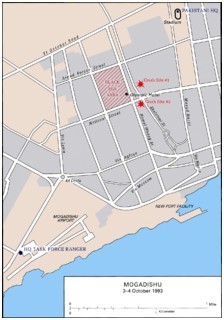
Map of the main battle sites during the Battle of Mogadishu.
In August 1993, Secretary of Defense Les Aspin directed the deployment of a Joint Special Operations Task Force (JSOTF) to Somalia in response to attacks made by General Mohamed Farrah Aidid's supporters upon U.S. and UN forces. The JSOTF, named Task Force (TF) Ranger, its mission named Operation Gothic Serpent was to capture Aidid. This was an especially arduous mission, for Aidid had gone underground, after several Lockheed AC-130 air raids and UN assaults on his strongholds.While Marines from the 24th MEU provided an interim QRF (Force Recon Det and helicopters from HMM-263), the task force arrived in the country, and began training exercises. The Marines were asked to take on the Aidid snatch mission, but having the advantage of being in the area for more than two months decided after mission analysis the mission was a "no-go" due to several factors centered around the inability to rescue the crew of a downed helicopter (re: the indigenous forces technique of using RPGs against helicopters and blocking the narrow streets in order to restrict the movement of a ground rescue force.) This knowledge was not passed on to the Rangers, due to the Marines operating from the USS Wasp and the Rangers remaining on land. TF Ranger was made up of operators from Delta Force, 75th Ranger Regiment, 160th SOAR, Air Force special tactics units, and SEALs from the Naval Special Warfare Development Group.During August and September 1993, the task force conducted six missions into Mogadishu, all of which were successes. Although Aidid remained free, the effect of these missions seriously limited his movements.
On 3 October, TF Ranger launched its seventh mission, this time into Aidid’s stronghold the Bakara Market to capture two of his key lieutenants. The mission was expected to take only one or two hours.Helicopters carried an assault and a ground convoy of security teams launched in the late afternoon from the TF Ranger compound at Mogadishu airport. The TF came under increasingly heavy fire, more intense than during previous missions. The assault team captured 24 Somalis including Aidid's lieutenants and were loading them onto the convoy trucks when a MH-60 Blackhawk was hit by a rocket-propelled grenade (RPG).A small element from the security force, as well as an MH-6 assault helicopter and an MH-60 carrying a fifteen man combat search and rescue (CSAR) team, rushed to the crash site. The battle became increasingly worse. An RPG struck another MH-60, crashing less than a mile to the south of the first downed helicopter. The task force faced overwhelming Somali mobs that overran the crash sites, causing a dire situation. A Somali mob overran the second site and, despite a heroic defense, killed everyone except the pilot, whom they took prisoner. Two defenders of this crash site, Master Sergeant Gary Gordon and Sergeant First Class Randall Shughart, were posthumously awarded the Medal of Honor. About this time, the mission’s quick reaction force (QRF) also tried to reach the second crash site. This force too was pinned by Somali fire and required the fire support of two AH-6 helicopters before it could break contact and make its way back to the base.
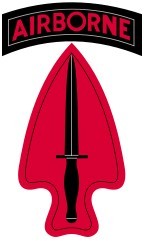
USASOC patch.
The assault and security elements moved on foot towards the first crash area, passing through heavy fire, and occupied buildings south and southwest of the downed helicopter. They fought to establish defensive positions so not to be pinned down by very heavy enemy fire, while treating their wounded, and worked to free the pilot’s body from the downed helicopter. With the detainees loaded on trucks, the ground convoy force attempted to reach the first crash site. Unable to find it amongst the narrow, winding alleyways, the convoy came under devastating small arms and RPG fire. The convoy had to return to base after suffering numerous casualties, and sustaining substantial damage to the their vehicles. Reinforcements, consisting of elements from the QRF, 10th Mountain Division soldiers, Rangers, SEALs, Pakistan Army tanks and Malaysianarmored personnel carriers, finally arrived at 1:55 am on 4 October. The combined force worked until dawn to free the pilot’s body, receiving RPG and small arms fire throughout the night.All the casualties were loaded onto the armored personnel carriers, and the remainder of the force was left behind and had no choice but to move out on foot.AH-6 gunships raked the streets with fire to support the movement. The main force of the convoy arrived at the Pakistani Stadium-compound for the QRF-at 6:30 am.
Thus concluding one of the bloodiest and fiercest urban firefights since the Vietnam War. Task Force Ranger experienced a total of 17 killed in action and 106 wounded. Various estimates placed Somali casualties above 1,000.Although Task Force Ranger's few missions were successes, the overall outcome of Operation Gothic Serpent was deemed a failure because of the Task Force's failure to complete their stated mission, capturing Mohamed Farrah Aidid.Most U.S. forces pulled out of Somalia by March 1994. The withdrawal from Somalia, was completed on March 1995.Even though Operation Gothic Serpent failed, USSOCOM still made significant contributions to operations in Somalia. SOF performed reconnaissance and surveillance missions, assisted with humanitarian relief, protected American forces and conducted riverine patrols. Additionally, they ensured the safe landing of the Marines and safeguarded the arrival of merchant ships carrying food.
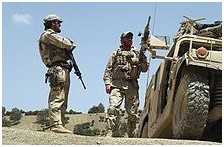
Special Forces on a patrol in Afghanistan.
Current Role
United States Special Operations Command played a pivotal role in fighting the former Taliban government in Afghanistan in 2001[24] and toppling it thereafter, as well as combating the insurgency and capturing Saddam Hussein in Iraq. USSOCOM in 2004 was developing plans to have an expanded and more complex role in the global campaign against terrorism, and that role continued to emerge before and after the killing of Osama bin Laden in Pakistan in 2011.In 2010, "of about 13,000 Special Operations forces deployed overseas, about 9,000 evenly divided between Iraq and Afghanistan."
Afghanistan
In the initial stages of the War in Afghanistan USSOCOM forces linked up with CIA Paramilitary Officers from Special Activities Division to defeat the Taliban without the need for large-scale conventional forces.This was one of the biggest successes of the global War on Terrorism.
These units linked up several times during this war and engaged in several furious battles with the enemy. One such battle happened during Operation Anaconda the mission to squeeze life out of a Taliban and Al-Qaeda stronghold dug deep into the Shah-i-Kot mountains of eastern Afghanistan. The operation was seen as one of the heaviest and bloodiest fights in the War in Afghanistan.
The battle on an Afghan mountaintop called Takur Ghar featured Special Operations forces from all 4 services and the CIA. Navy SEALs, Army Rangers, Air Force Combat Controllers, and Pararescuemen fought against entrenched Al-Qaeda fighters atop a 10,000-foot (3,000 m) mountain. Subsequently, the entrenched Taliban became targets of every asset in the sky. According to an executive summary, the battle of Takur Ghar was the most intense firefight American special operators have been involved in since 18 U.S. Army Rangers were killed in Mogadishu, Somalia, in 1993.During Operation Red Wing on 28 June 2005, four Navy SEALs, pinned down in a firefight, radioed for help. A Chinook helicopter, carrying 16 service members, responded but was shot down. All members of the rescue team and three of four SEALs on the ground died. It was the worst loss of life in Afghanistan since the invasion in 2001. The Navy SEAL Marcus Luttrell alone survived. Team leader Michael P. Murphy was awarded the Medal of Honor for his actions in the battle.
Iraq
USSOCOM's 10th Special Forces Group, elements of JSOC and CIA/SAD Paramilitary Officers linked up again and were the first to enter Iraq prior to the invasion. Their efforts organized the Kurdish Peshmerga to defeat Ansar Al Islam in Northern Iraq before the invasion. This battle was for control of a territory in Northeastern Iraq that was completely occupied by Ansar Al Islam, an ally of Al Qaeda. This was a very significant battle and led to the termination of a substantial number of terrorists and the uncovering of a chemical weapons facility at Sargat. These terrorists would have been in the subsequent insurgency had they not been eliminated during this battle. Sargat was the only facility of its type discovered in the Iraq war. This battle may have been the Tora Bora of Iraq, but it was a sound defeat for Al Qaeda and their ally Ansar Al Islam.[citation needed] This combined team then led the Peshmerga against Saddam's northern Army. This effort kept Saddam's forces in the north and denied the ability to redeploy to contest the invasion force coming from the south. This effort may have saved the lives of hundreds if not thousands of coalition service men and women.
At the launch of the Iraq War dozens of 12-member Special Forces teams infiltrated southern and western Iraq to hunt for Scud missiles and pinpoint bombing targets. Scores of Navy SEALs seized oil terminals and pumping stations on the southern coast.Air Force combat controllers flew combat missions in MC-130H Combat Talon IIs and established austere desert airstrips to begin the flow of soldiers and supplies deep into Iraq. It was a far cry from the Persian Gulf war of 1991, where Special Operations forces were kept largely on the sidelines. But it would not be a replay of Afghanistan, where Army Special Forces and Navy SEALs led the fighting. After their star turn in Afghanistan, many special operators were disappointed to play a supporting role in Iraq. Many special operators felt restricted by cautious commanders.From that point, USSOCOM has since killed or captured hundreds of insurgents and Al-Qaeda terrorists. It has conducted several foreign internal defense missions successfully training the Iraqi security forces.
Global presence
SOC chief Olson said in 2011 that SOCOM "is a microcosm of the Department of Defense, with ground, air, and maritime components, a global presence, and authorities and responsibilities that mirror the Military Departments, Military Services, and Defense Agencies."In 2010, special forces were deployed in 75 countries, compared with about 60 at the beginning of 2009.In 2011, SOC spokesman Colonel Tim Nye (Army) was reported to have said that the number of countries with SOC presence will likely reach 120 and that joint training exercises will have been carried out in most or all of those countries during the year. One study identified joint-training exercises in Belize, Brazil, Bulgaria, Burkina Faso, Germany, Indonesia, Mali, Norway, Panama, and Poland in 2010 and also, through mid-year 2011, in the Dominican Republic, Jordan, Romania, Senegal, South Korea, and Thailand, among other nations. In addition, SOC forces executed the high profile killing of Osama bin Laden in Pakistan in 2011.
Wikileaks' releases of cables from the U.S. Embassy, Pakistan, revealed the presence of a detachment of SOCOM (or possibly United States Army Special Operations Command) referred to as SOC(FWD)-PAK (09ISLAMABAD2449, 9 August 2010). This unit or headquarters may be, in full form, Special Operations Command (Forward)-Pakistan. It seems unlikely that the – symbol refers to the minus sign that sometimes means that the unit or headquarters is operating at less than full strength. The unit or headquarters includes a Military Information Support Team (MIST ), according to http://www.imgc-global.com/testimonials.html. Retrieved February 2012. Another story that reported on JSOC/Blackwater anti-terrorist operations in Pakistan was Jeremy Scahill's The Secret U.S. War in Pakistan, in the 7 November 2009, issue of The Nation.
In 2010, White Housecounterterrorism director John O. Brennan said that the United States "will not merely respond after the fact" of a terrorist attack but will "take the fight to al-Qaeda and its extremist affiliates whether they plot and train in Afghanistan, Pakistan, Yemen, Somalia and beyond." Olson said, "In some places, in deference to host-country sensitivities, we are lower in profile. In every place, Special Operations forces activities are coordinated with the U.S. ambassador and are under the operational control of the four-star regional commander."
The conduct of actions by SOC forces outside of Iraq and Afghan war zones has been the subject of internal U.S. debate, including between representatives of the Bush administration such as John B. Bellinger III, on one hand, and the Obama administration on another. The United Nations in 2010 also "questioned the administration's authority under international law to conduct such raids, particularly when they kill innocent civilians. One possible legal justification – the permission of the country in question – is complicated in places such as Pakistan and Yemen, where the governments privately agree but do not publicly acknowledge approving the attacks," as one report put it.
On 24 January 2012, the Military Sealift Command posted a rush-order bid to convert the aging USS Ponce, which had been scheduled for decommissioning, into a makeshift staging base unofficially dubbed a “mothership,” to accommodate small high-speed boats and helicopters commonly used by Navy SEALs.
Subordinate Commands
Joint Special Operations Command
USSOCOM cannot conduct covert action operations, as the Central Intelligence Agency (CIA) is the only organization that has the authority to conduct these actions. However, USSOCOM has a close relationship with the CIA's elite Special Activities Division and the two forces often operate together, with significant positive results according to several sources. The CIA's Special Activities Division's Special Operations Group exclusively selects their recruits to become Paramilitary Operations Officers from the ranks of USSOCOM and primarily JSOC's Tier OneSpecial Mission Units.
Units
• The Army 1st Special Forces Operational Detachment-Delta (Combat Applications Group (CAG), Delta Force) is the first of the two primary counter-terrorist units of JSOC and SOCOM.Modeled after the British special forces regiment, the Special Air Service, Delta Force is one of the best SOFs in the world. This is because of Delta's stringent training and selection process. Delta recruits primarily from the most talented and highly skilled operators in the Army Special Forces and the 75th Ranger Regiment although CAG will take anyone and everyone that can pass their screening.Recruits must pass a rigid selection course before beginning training. Delta has received training from numerous U.S. government agencies and other tier one SOF and has created a curriculum based on this training and techniques that it has developed.Delta conducts clandestine and covert special operations all over the world.[49] It has the capability to conduct a myriad of special operations missions but specializes in counter-terrorism and hostage rescue operations.
• Naval Special Warfare Development Group (DEVGRU, SEAL Team 6) is the second of the two primary counter-terrorist units of JSOC and SOCOM.[48] DEVGRU is the Naval Special Warfare's counter-part to Delta. Like Delta, DEVGRU recruits the best operators from the best units in its branch, the Navy SEALs. DEVGRU is also capable of performing any type of special operations mission, but trains especially for maritime counter-terrorist operations.
• The Intelligence Support Activity (ISA, The Activity) is the support branch of JSOC and USSOCOM. Its primary missions are to provide Human Intelligence (HUMINT) and Signal Intelligence (SIGINT) mainly for Delta and DEVGRU's operations.Before the establishing of the Strategic Support Branch in 2001, the ISA needed the permission of the CIA to conducts its operations which sometimes caused it to be less effective in its support of JSOC's primary units.
• The Air Force 24th Special Tactics Squadron (24th STS) is the AFSOC component of JSOC. The 24th STS operates similarly to the 720th Special Tactics Group. The 24th STS usually operates with Delta and DEVGRU because of the convenience of 24th STS ability to synchronize and control the different elements of air power and enhance air operations deep in enemy territory.
Portions of JSOC units have made up the constantly changing special operations task force, operating in the U.S. Central Command area of operations. The Task Force 11, Task Force 121, Task Force 6-26 and Task Force 145 are creations of the Pentagon's post-11 September campaign against terrorism, and it quickly became the model for how the military would gain intelligence and battle insurgents in the future. Originally known as Task Force 121, it was formed in the summer of 2003, when the military merged two existing Special Operations units, one hunting Osama bin Laden in and around Afghanistan, and the other tracking Sadaam Hussein in Iraq.
Special Operations Command – Joint Capabilities
Special Operations Command – Joint Capabilities (SOC-JC) was transferred to USSOCOM from the soon to be disestablished United States Joint Forces Command.
Primary Mission: SOC-JC trains conventional and SOF commanders and their staffs, supports USSOCOM international engagement training requirements, and supports implementation of capability solutions in order to improve strategic and operational Warfighting readiness and joint interoperability. SOC-JC must also be prepared to support deployed Special Operations Joint Task Force (SOJTF) Headquarters (HQ).
As a joint sub-unified command under USSOCOM, SOC-JC’s core function is to enhance the interoperability of conventional and Special Operations Forces (SOF) commanders and staffs through robust strategic and operational level joint training. In coordination with the USSOCOM J3, J7/9 and Joint Special Operations University (JSOU), SOC-JC provides excellent training and support to the education for SOF and Conventional Forces (CF) worldwide. Additionally, SOC-JC supports the joint SOF capabilities development process while maintaining the flexibility to support emerging initiatives.
Army
On 1 December 1989 the United States Army Special Operations Command (USASOC) activated as the 16th major Army command. These special operations forces have been America's spearhead for unconventional warfare for more than 40 years. USASOC commands such units as the well known Special Forces (SF) and Rangers, and such relatively unknown units as the Psychological Operations Group (PSYOP) and Civil Affairs Brigade (CA). These are one of the USSOCOM's main weapons for waging unconventional warfare and counter-insurgency. The significance of these units is emphasized as conventional conflicts are becoming less prevalent as insurgent and guerrilla warfare increases.
Units
• The 75th Ranger Regiment (US Army Rangers) is the premier light-infantry unit of the United States Army and is headquartered at Fort Benning, Georgia. The 75th Ranger Regiment’s mission is to plan and conduct special missions in support of U.S. policy and objectives.The Rangers are a flexible and rapid-deployable force. Each battalion can deploy anywhere in the world with 18 hours notice. The Army places much importance on the 75th Ranger Regiment and its training; it possesses the capabilities to conduct conventional and most special operations missions. Rangers are capable of infiltrating by land, sea, or air and direct action operations such as conducting raids or assaulting buildings or airfields.
• United States Army Special Forces (SF) aka Green Berets perform several doctrinal missions: unconventional warfare, foreign internal defense, special reconnaissance, direct Action, counter-terrorism and counter-proliferation. These missions make Special Forces unique in the U.S. military, because they are employed throughout the three stages of the operational continuum: peacetime, conflict and war.
Foreign Internal Defense operations, SF’s main peacetime mission, are designed to help friendly developing nations by working with their military and police forces to improve their technical skills, understanding of human rights issues, and to help with humanitarian and civic action projects. Special Forces unconventional warfare capabilities provide a viable military option for a variety of operational taskings that are inappropriate or infeasible for conventional forces. Special Forces are the U.S. military’s premier unconventional warfare force.
Foreign internal defense and unconventional warfare missions are the bread and butter of Special Forces soldiers. For this reason SF candidates are trained extensively in weapons, engineering, communications and medicine. SF soldiers are taught to be warriors first and teachers second because they must be able to train their team and be able to train their allies during a FID or UW mission.[61][63] Often SF units are required to perform additional, or collateral, activities outside their primary missions. These collateral activities are coalition warfare/support, combat search and rescue, security assistance, peacekeeping, humanitarian assistance, humanitarian de-mining and counter-drug operations.
• The 160th Special Operations Aviation Regiment (Night Stalkers) headquartered at Fort Campbell, Kentucky provides aviation support to units within USSOCOM. The Regiment consists of MH-6 and AH-6 light helicopters, MH-60 helicopters and MH-47 heavy assault helicopters. The capabilities of the 160th SOAR (A) have been evolving since the early 1980s. Its focus on night operations resulting in the nickname, the "Night Stalkers." The primary mission of the Night Stalkers is to conduct overt or covert infiltration, exfiltration, and resupply of special operations forces across a wide range of environmental conditions.
• 4th Psychological Operations Group (Airborne) Soldiers use persuasion to influence perceptions and encourage desired behavior.[67][68] 4th PSYOP Gp supports national objectives at the tactical, operational and strategic levels of operations. Strategic psychological operations advance broad or long-term objectives; global in nature, they may be directed toward large audiences or at key communicators. Operational psychological operations are conducted on a smaller scale. 4th PSYOP Gp is employed by theater commanders to target groups within the theater of operations. 4th PSYOP Gp purpose can range from gaining support for U.S. operations to preparing the battlefield for combat. Tactical psychological operations are more limited, used by commanders to secure immediate and near-term goals. In this environment, these force-enhancing activities serve as a means to lower the morale and efficiency of enemy forces.
• 95th Civil Affairs Brigade (Airborne) specialists identify critical requirements needed by local citizens in war or disaster situations. They also locate civilian resources to support military operations, help minimize civilian interference with operations, support national assistance activities, plan and execute noncombatant evacuation, support counter-drug operations and establish and maintain liaison with civilian aid agencies and other nongovernmental organizations. In support of special operations, these culturally oriented, linguistically capable Soldiers may also be tasked to provide functional expertise for foreign internal defense operations, unconventional warfare operations and direct action missions.
• Sustainment Brigade (Special Operations) (Airborne) (SBSO(A)) has a difficult mission supporting USASOC. In their respective fields, signal and support soldiers provide supplies, maintenance, equipment and expertise allowing Special Operation Forces to "shoot, move and communicate" on a continuous basis. Because USASOC often uses Special Operations Forces-unique items, soldiers assigned to these units are taught to operate and maintain a vast array of specialized equipment not normally used by their conventional counterparts. SBSO(A) also provides the USASOC with centralized and integrated material management of property, equipment maintenance, logistical automation and repair parts and supplies.
• John F. Kennedy Special Warfare Center (USAJFKSWCS) trains USSOCOM and Army Special Operations Forces through development and evaluation of special operations concepts, doctrines and trainings
Share this page



















